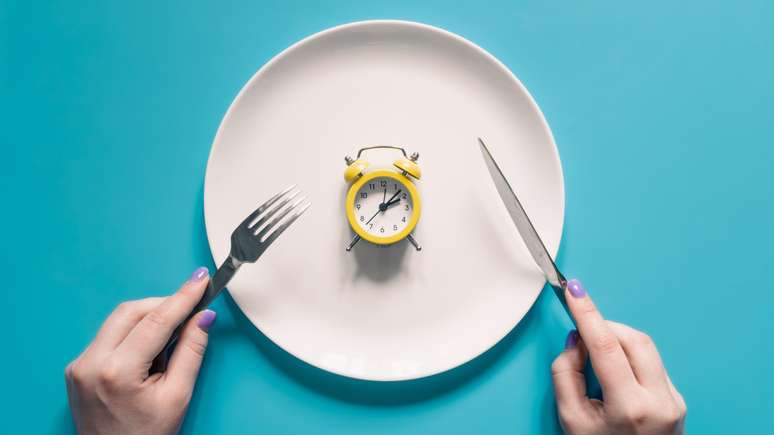Homeopathic pharmacist Jamar Tejada provides all the details on the practice of intermittent fasting, but clarifies who, in fact, can perform it
Many people know that I practice intermittent fasting, so I get a lot of questions. Today I decided to share with you this practice that has been part of my routine since the beginning of the pandemic.
html[data-range=”xlarge”] figure image img.img-88f03fdd0785893c09a24287e5499fced76a1f07 { width: 774px; height: 435px; }HTML[data-range=”large”] figure image img.img-88f03fdd0785893c09a24287e5499fced76a1f07 { width: 548px; height: 308px; }HTML[data-range=”small”] image figure img.img-88f03fdd0785893c09a24287e5499fced76a1f07, html[data-range=”medium”] figure figure img.img-88f03fdd0785893c09a24287e5499fced76a1f07 { width: 564px; height: 317px; }
Let’s start from the beginning, because although this practice has become a fad, many are unaware of it. Intermittent fasting is when you alternate periods of fasting — in which you only ingest water and noncaloric beverages, such as unsweetened tea and coffee — until there’s no food intake hours later.
Intermittent fasting is a strategy that many use to lose weight. By practicing it, the idea is to force the body to use fat stores as the main source of energy in daily activities, focusing on reducing fat mass – one of the reasons I do it. But there are those who practice for other reasons.
My housekeeper, for example, noticed that I only ever had coffee in the morning and asked me if it was a promise. She wasn’t wrong, as many do for religious or political reasons.
Although now a trendy practice, it has been practiced for thousands of years and is one of the oldest proven medical therapies in history. Since the days of the father of Western medicine, Hippocrates, fasting has been recommended as a cure for both acute and chronic illnesses, following the observation that infection was often accompanied by loss of appetite.
Like Hippocrates, other great names in history, such as Pythagoras, Plato, Asclepiades and Plutarch, extolled the therapeutic powers of fasting. Ayurvedic Medicine, the oldest healing system in the world, proposes fasting as an important treatment, such as the practice of Ekadasi, based on the phases of the moon and practiced for over 5,000 years.
Basic principles of intermittent fasting
First it is important to know that, in order to start intermittent fasting, the individual must already have healthy eating habits, because fasting and then sticking your “foot in the jackfruit” with poor, nutrient-free and inflammatory foods will only hurt you .
Another important thing to know is that, in terms of weight loss, there isn’t much difference in results between intermittent fasting done correctly and a balanced diet with a calorie deficit with no fasting periods. So ask a nutrilogist, endocrinologist or nutritionist for advice, okay? Don’t start it yourself, always seek professional help.
While there is no evidence that fasting is dangerous or can cause harm to your health (if done anyway), this habit can cause a variety of deficiencies and complications such as: low immunity, dizziness, headaches, dehydration, hypoglycemia, weakness, anemia, cognitive dysfunction, constipation, hair loss and muscle wasting. Not to mention, you can get extremely anxious and irritable.
Who can do?
Intermittent fasting is not a recommended program for everyone. It is recommended, in general, to those who have been following a balanced diet for some time, and above all to those who follow a low carbohydrate diet.
It should not be done by children, the elderly, pregnant and breastfeeding women, those suffering from type 1 diabetes or those who are insulin dependent.
As far as athletes are concerned, there are many contradictions. But, given the benefits and few negative outcomes, this may be a dietary strategy for certain preparation periods, such as when you need to accelerate weight loss in a shorter period of time.
Where does the energy for the functioning of the body come from during fasting?
Our body is a constantly functioning machine and, even when we are still, we consume, we always burn energy, both for breathing and for thinking. The car can’t stop, so what will supply this needed fuel is the glucose stored in the liver, the fat and protein in the muscle.
First, our body seeks glucose stored in the liver as an energy source, then fat, and finally muscle protein. The hormones cortisol, GH and adrenaline stimulate the liver to release glucose. The liver has glucose stored in a form called glycogen. This happens in the first hours of fasting.
The process works as follows: first, almost all the glycogen in the liver will be used up, and then it will start burning fat. But while you’re consuming the glucose from your liver, your body has already started burning fat and muscle.
The breakdown of fats is a slower process and takes place in the form of ketone bodies which pass through the bloodstream, go to the liver and only there are they transformed into glucose. Only on this journey can they be used by the brain as an energy source. Therefore, when the person is without food for a period, there is that characteristic ketone-smelling breath.
Of course, fasting is possible to lose weight quickly, but the first consequence is the famous accordion effect – if you go back to your old eating habits. By the way, you will regain the lost weight even faster.
In order to practice intermittent fasting, it is also necessary to understand that there are different methods of doing it, which vary according to the frequency and length of the fasting periods and the eating windows that will be interspersed in the process.
Some methods most used by health professionals:
Method 8/16: daily fasts of approximately 16 hours and an 8-hour eating window. Also common are 12/12 and 4/20, in which the person fasts for 12 or 20 hours, respectively, and eats within a 12 or 4 hour window.
The 5:2 Diet: when there is ingestion of meals for five days of the week and restriction of caloric intake for two days of the week.
Eat-Stop-Eat method: in which the person chooses one or two days of the week in which he will fast completely. On these days, the person will eat and then eat again at the same time the next day.
And what are the advantages?
Regulates cholesterol and triglyceride levels: this is because the food consumed before and after fasting must be low in sugar and fat, as well as being rich in fiber, promoting the elimination of excess fat, improving cholesterol and triglyceride levels in the blood, increasing those of good fats ( HDL), which leads to the prevention of high blood pressure.
Prevent Diabetes: Intermittent fasting combined with a low intake of sugar in the diet helps balance blood glucose and insulin levels, preventing diabetes.
Boost Your Metabolism: In controlled intermittent fasting, the low-calorie intake reduces blood glucose and insulin levels, causing the body to use the body’s fat cells for energy and boost metabolism. Contrary to the belief that fasting can slow down your metabolism, this only happens when you fast for more than 48 hours.
To lose weight: fasting for at least 16 hours without eating decreases the levels of the hormone insulin in the blood, as well as stimulating the body to use sugar stores and fat cells, directly contributing to weight loss.
Detoxify the body: improves the circadian cycle of the intestine and stimulates detoxification, as it helps to increase the activity of the intestinal migratory motor complex (IMM) – a muscle contraction mechanism that has the function of “cleaning” and sweeping away the remains of the food bolus and bacteria from the upper gastrointestinal tract to the large intestine. It also helps repair the permeability of the mucous membrane, aids in “detoxification” and relieves symptoms such as swelling.
Finally, I believe that intermittent fasting is not a good choice in nutrition rehabilitation. It’s good for those who already have a healthier lifestyle.
It is important to underline that if you do intermittent fasting with the aim of losing weight, you must also respect the daily calorie deficit, which is essential in the fat burning process. In no way do I call it a miracle formula. Everyone knows their limits, or at least they should!
Consult your doctor/nutritionist and good luck!
Source: Terra
Ben Stock is a lifestyle journalist and author at Gossipify. He writes about topics such as health, wellness, travel, food and home decor. He provides practical advice and inspiration to improve well-being, keeps readers up to date with latest lifestyle news and trends, known for his engaging writing style, in-depth analysis and unique perspectives.









